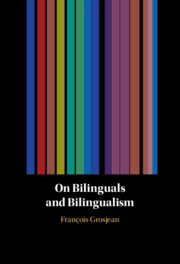Book contents
- On Bilinguals and Bilingualism
- On Bilinguals and Bilingualism
- Copyright page
- Dedication
- Contents
- Figures
- Tables
- Introduction
- 1 The Setting
- 2 A Holistic View of Bilingualism
- 3 The Bilingual’s Language Modes
- 4 The Complementarity Principle
- 5 Spoken Language Processing
- 6 Cross-linguistic Influence
- 7 Bilinguals Who Are Also Bicultural
- 8 The Bilingualism and Biculturalism of the Deaf
- 9 The Statistics of Bilingualism
- 10 Special Bilinguals
- 11 A Bilingualism Researcher’s Social Role
- Appendix The Right of the Deaf Child to Grow Up Bilingual
- References
- Index
5 - Spoken Language Processing
Published online by Cambridge University Press: 08 February 2024
- On Bilinguals and Bilingualism
- On Bilinguals and Bilingualism
- Copyright page
- Dedication
- Contents
- Figures
- Tables
- Introduction
- 1 The Setting
- 2 A Holistic View of Bilingualism
- 3 The Bilingual’s Language Modes
- 4 The Complementarity Principle
- 5 Spoken Language Processing
- 6 Cross-linguistic Influence
- 7 Bilinguals Who Are Also Bicultural
- 8 The Bilingualism and Biculturalism of the Deaf
- 9 The Statistics of Bilingualism
- 10 Special Bilinguals
- 11 A Bilingualism Researcher’s Social Role
- Appendix The Right of the Deaf Child to Grow Up Bilingual
- References
- Index
Summary
The author has spent a large part of his research career studying spoken language processing in bilinguals. In this chapter, he first gives a brief overview of the stages involved in speech perception and comprehension; that is, how the listener goes from the acoustic wave all the way to the interpretative representation. He then describes a number of studies he undertook that concern primarily the processing of bilingual mixed speech. The research deals with the gender marking effect (late bilinguals appear to be largely insensitive to gender congruency and incongruency), the base-language effect (in normal bilingual discourse, base‐language units – i.e. phonemes, syllables and words – are favored over guest‐language units, at least for a short period of time), and the recognition of guest words. Here, the author showed evidence for a number of effects that occur when guest words are recognized in bilingual speech, such as a language phonetic effect, a phonotactic effect, an interlanguage homophonic status effect, and a base-language effect. He ends the chapter by describing a spoken word recognition model for bilinguals that accounts for the effects found.
Keywords
- Type
- Chapter
- Information
- On Bilinguals and Bilingualism , pp. 76 - 92Publisher: Cambridge University PressPrint publication year: 2024

